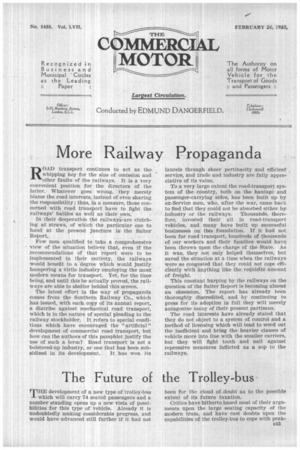The Future of the Trolley-bus
Page 29

Page 30

If you've noticed an error in this article please click here to report it so we can fix it.
rrEIE development of a new type of trolley-bus which will carry 74 seated passengers and a number standing opens up a new vista of possibilities for this type of vehicle. Already it is undoubtedly making considerable progress, and would have advanced still further if it had not been for the cloud of doubt as to the possible extent of its future taxation.
Critics have hitherto based most of their arguments upon the large seating capacity of the modern tram, and have cast doubts upon the capabilities of the trolley-bus to cope with peak hour loads ; but, in many Instances, these doubts have already been dispelled, because the essential mobility of this vehicle, combined with its remarkable powers of acceleration and braking, has enabled services to be so expedited that any belikved disability has shown itself to be phantau agoric.
Now, with the improved edition, the case for the trolley-bus becomes even stronger, and a dechlod impetus should be given to the substitution of this type for the older means for transport.
At one time the trolley-bus was looked upon by many tramway engineers as a stage in the move from the tram to the bus, but modern thought tends to regard the trolley-bus as a very satisfactory and permanent means for tram supersession, which can make use of existing power plants and thus utilize home-produced fuel.
An Important French Trial.
WE believe that it would be advantageous to some of our makers to enter vehicles for the French Raffle des Carburants Nationaux, which, this year, is to be combined with the M.C.F. Tour de France. For the first time there will be an industrial-vehicle section, and the trial will be extended into Belgium.
This demonstration is more than a test of reliability ; it is, in effect, a travelling motor show, as the vehicles will be exhibited in every town where a halt of at least half a day is made. The appearance and performance of British vehicles would certainly have an excellent effect, and recently we have been carrying out much work on fuels other than petrol.
The Need for Cheaper Oil Engines.
BBRITISH designers and producers of oil engines must not be content to rest upon their laurels. Very satisfactory power units of this type have been developed, but there still exists an important need for smaller types suitable for the lighter classes of vehicle.
We know that there are certain developments In this connection, and we consider that every encouragement should be given to them, particularly as there is a strong probability that, in the future, the average load-carrying capacity of commercial vehicles will be somewhat below that now existing.
There is also the need for the production of engines which can be sold at a lower figure and yet retain the characteristics of long life, reliability and low consumption., The economy of the oil-engined vehicle -is striking, but even this cannot always outweigh a disproportionate capital expenditure. This last point will also carry more weight if any new scale of taxation which may be instituted throws extra annual charges upon those vehicles equipped with compression-ignition engines.




























































































